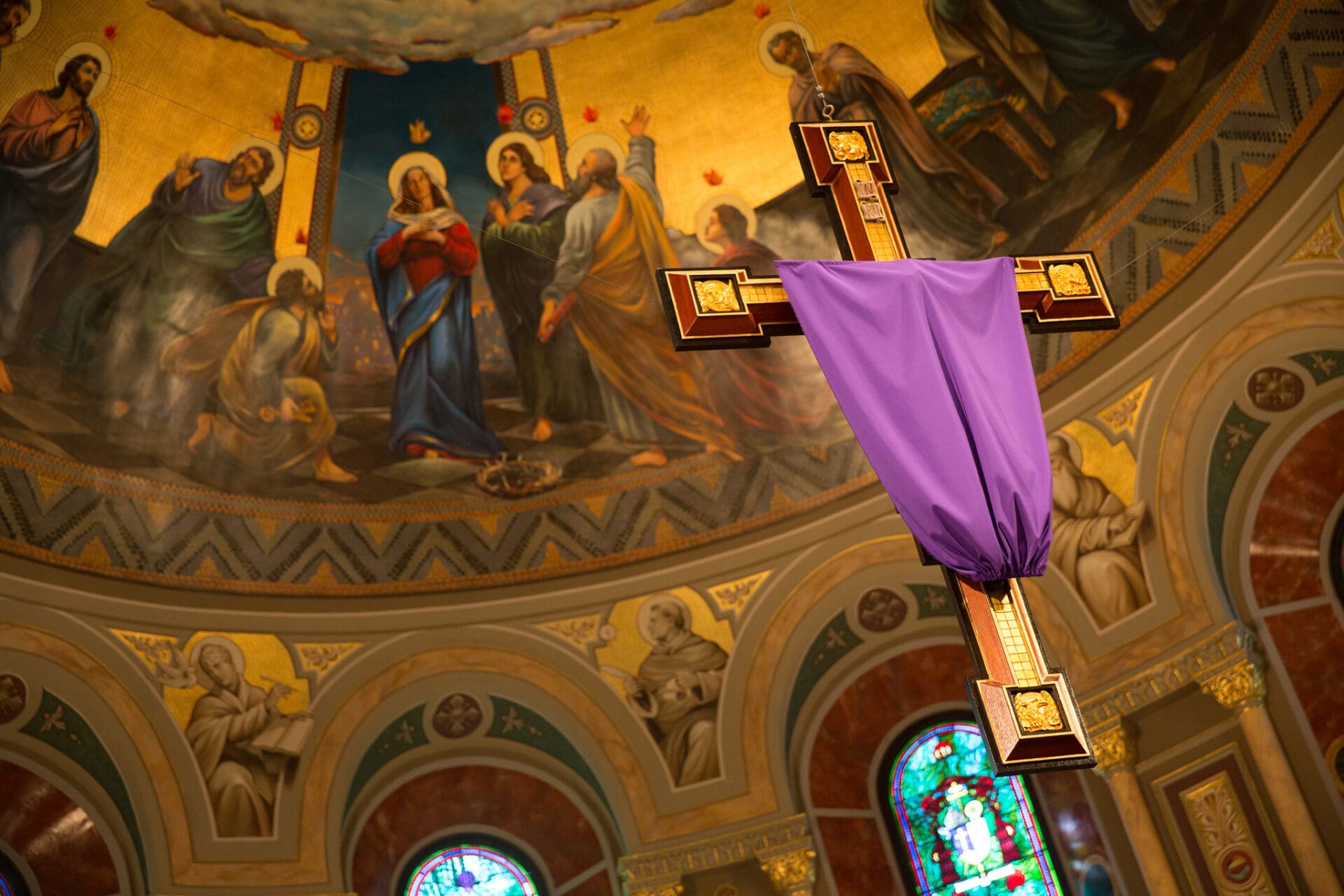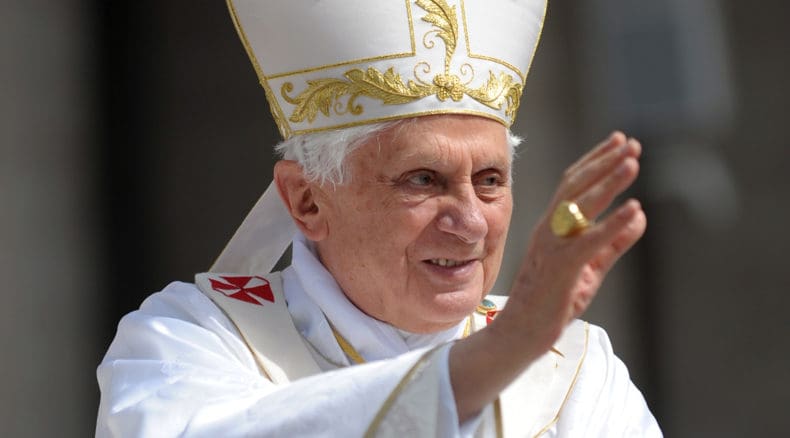“Don’t process with palms on Palm Sunday.”
“Don’t wash feet on Holy Thursday.”
“Don’t kiss the cross on Good Friday.”
“Don’t sprinkle holy water at the Easter Vigil.”
Will these be the guidelines for Easter 2022?
For sure, as the above litany of “Don’t’s” has made abundantly clear, the Church’s Holy Week celebrations have lacked a lot of luster for the past two years due to COVID-19 precautions. Like every other aspect of life—trips to the store, the gym, the movie theater—the Church’s public, communal worship has become a COVID casualty. But as of this writing, there appear no special Holy Week guidelines from the Holy See for 2022, nor do most dioceses appear eager to offer any directives.
But this doesn’t necessarily mean we ought to rejoice in being able to go back to the Holy Week celebrations of 2019. In many places, and for many years—long before COVID and pandemic became part of our common cultural lexicon—the grand liturgies of Holy Week had not been as radiant as they should have been—and we didn’t have a virus to blame it on back then, either. In some ways, COVID is less a hindrance to our liturgies than we ourselves are.
Whatever the causes of past Holy Week liturgies poorly celebrated, we have a great opportunity in 2022 to do our part to bring back to life these most important rites of the year. Christ, of course, and with him, Father and Holy Spirit, will continue to work flawlessly to manifest in our midst the saving Paschal Mystery. But liturgy isn’t magic, and grace doesn’t penetrate our souls like osmosis—however much we wish this were the case at times. Rather, liturgy is a co-operation, a co-working, and a co-laboring (or collaboration). Consequently, priests and those ministers who assist him must hone their respective skill sets and bring to the Holy Week liturgies an ars celebrandi, or “art of celebrating,” that reveals the radiant beauty of salvation through Christ in our midst. In addition to the ministers’ ars celebrandi, the lay faithful must prepare themselves to participate actively and intelligently and not, as Pope Pius XII once wrote, as “dumb and idle spectators” (Musicae Sacrae Disciplina, 64).
I’d like to suggest, then, a few ways that both priests and people can prepare themselves to “resurrect” our 2022 Holy Week liturgies. As a layman, I have less influence on what my bishop or pastor might do. (The “power” wielded by a diocesan liturgy director or parish music director—both of which I am—is not as great as some may think!) But as a baptized member of the Church and the father of a family, there is much in my control that I can contribute.
Palm Sunday. I am not a priest, nor have I ever been one. But were I to suggest anything to a priest and his assisting ministers it would be to prepare well, and well in advance, not only by studying and mastering the various ritual celebrations but also by praying. Just as nature abhors a vacuum, liturgy abhors chaos. Indeed, liturgy is this fallen world’s cosmetic: it has the power to re-order the dis-order by beautifying and sanctifying it. And while it is undeniably true that the Holy Week liturgies have their fair share of complexity and unique features that make demands on priests, it is also true that (as one pastor told me) the Holy Week schedule is also usually simpler than the Christmas schedule. For most pastors, there is only one Holy Thursday celebration, one Good Friday liturgy, and one Easter Vigil Mass. (Compare this schedule to the multiple Masses celebrated during the Christmas-Holy Family weekend in 2021).
As far as the people are concerned, the Church recommends that we remember our guardian angels and patron saints. A closer look at the Lenten liturgies finds these supernatural companions everywhere. Jesus is comforted by angels after his temptations in the desert, which we heard about back on the First Sunday of Lent; he is likewise comforted by an angel at his agony in the garden, which we hear proclaimed on Palm Sunday and Good Friday. Did you know that the Church recommends singing the Litany of the Saints during the entrance procession on the First Sunday of Lent (see Paschalis Sollemnitatis, 23)? And presuming there are baptisms being celebrated at particular parishes during the Easter Vigil, the Litany of the Saints will resound again to help welcome the new members into the Body of Christ. So as Holy Week begins on Palm Sunday, be sure you are travelling in good company.
Holy Thursday. There’s a rubric at the Mass of the Lord’s Supper that is a remarkable sign to the parish. “At an appropriate moment during Communion, the Priest entrusts the Eucharist from the table of the altar to Deacons or acolytes or other extraordinary ministers, so that afterwards it may be brought to the sick who are to receive Holy Communion at home” (33). For sure, exercising this option will require of priests and ministers even more planning than usual (e.g., organizing enough Eucharistic Ministers, and alerting the homebound to expect a visit late Holy Thursday evening!). But if the pandemic has taught us anything, it is that sizable portions of our parish will choose to participate remotely—even as they (and we) require human contact.
Another of Holy Thursday’s rubrics makes demands on the people. “At the beginning of the Liturgy of the Eucharist, there may be a procession of the faithful in which gifts for the poor may be presented with the bread and wine” (14). Whether or not your parish actually has such a procession at the Mass of the Lord’s Supper, there is no reason we faithful cannot make extra efforts on this day to support the poor in our midst. And speaking of support, Holy Thursday’s Chrism Mass (which may take place on another day leading up to Easter) hears priests renew their priestly promises and calls upon the faithful to hold our priests and their priesthood in prayer. Consider attending your diocesan Chrism Mass—you will be glad you did.
Good Friday. Priests and ministers are obliged to give their people something to behold on this day. Indeed, the word Ecce—“Behold!”—occurs a number of times on Good Friday: “Behold, the man!” during the Gospel; “Behold, the wood of the Cross,” during the showing of the Cross; and, as at Mass, “Behold, the Lamb of God” prior to the reception of Holy Communion. So that each of these visions are of Jesus himself (and not his ministers), ministers must strive to proclaim the Passion reading as it deserves, without idiosyncratic innovations (as is sometimes the case). They should also use a cross of “appropriate size and beauty” (Paschalis Sollemnitatis, 68) and not one of “real-life” slabs of wood. Most importantly, priests and ministers ought to treat the Eucharist on this day of its birth from Christ’s side in an especially reverent way.
The ordained priesthood is not the only group called upon to celebrate well on this day of Christ’s priestly offering; the baptismal priesthood is likewise expected to exercise its priestly power in a special way during the Universal Prayer. You will remember the rather extended process of the petitions on this day: 1) “Let us pray for the Pope…” (for example), 2) “Let us kneel,” 3) prayer in silence, 4) “Let us stand,” 5) collect recited, and 6) “Amen”—ten or more times! Priests intercede and meditate between God and man, heaven and earth. To make this priestly action as efficacious as possible, why not borrow a missalette or hymnal from the parish beforehand and consider thoughtfully, intentionally those persons for whom we are called to pray?
Easter Vigil. Grace is mediated through sacramental signs and symbols. The rites that compose the Easter Vigil’s Lucernarium—the blessing of the fire and the candle, the procession into the church building, and the singing of the Exsultet—are among the most powerful sacred symbols used throughout the year. But only if they are used! Night can do its symbolic best, and the fire’s light radiate its sacramental power, only if the Vigil actually begins in darkness, as the rubrics direct (Paschalis Sollemnitatis, 78). The marking of the candle with the sign of the cross, the Alpha and Omega, and the numerals 2022 are to be cut with a stylus, not traced upon plastic stickers—in much the same way that the faithful are supernaturally, yet really, marked by baptism. Coals are to be taken from the Easter fire and shoveled into the thurible on this night, rather than using pre-packaged charcoals, since the fire is the new Fiat lux of all that lies ahead. There are many occasions for shortcuts at the start of the Easter Vigil: and there are many occasions for sacramental grace. A priest’s ars celebrandi is especially important at this time.
One of the numerous high points of the Vigil is the celebration of the Sacrament of Baptism, or at least the renewal of baptismal promises. We have heard, unfortunately, too many recent stories of invalid baptisms resulting from a minister using an invalid formula. May each of us come to appreciate the great gift of baptism ever more at the upcoming Vigil. Listen and respond with conviction to the priest’s questions at the renewal of our promises. Meditate beforehand about their meaning. Reflect afterward (especially with children and grandchildren) on the obligations and privileges that baptism entails.
A great deal of work lies ahead for us Catholics during Holy Week. There is, of course, much more that can be suggested; indeed, consider coming up with your own to-do list. But if these few ideas appear to be a lot to ask of priests and parishioners coming out of two years of relative paschal inaction, recall that the Olympics didn’t wait, nor did Super Bowls, elections, or the school year (however delayed or modified these important secular events may have been). Christ will do his part this Easter, but his clergy and laity must do theirs. If we do, then Holy Week may be for the first time in a long time a fuller expression of the true font of divine life.
Image Source: AB/Archdiocese of Boston on Flickr


